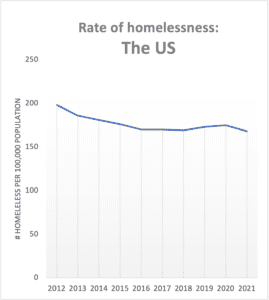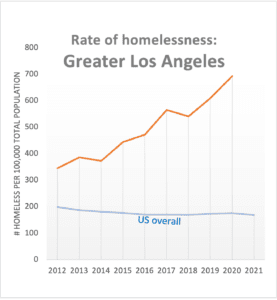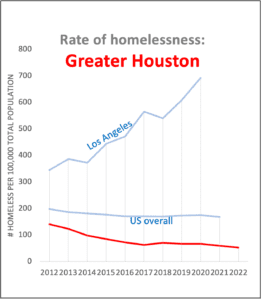Homelessness
 Overall homelessness in America has declined to some degree in the past decade even as the total US population has grown.
Overall homelessness in America has declined to some degree in the past decade even as the total US population has grown.
These numbers are based on annual point-in-time headcounts of homeless people for the US Department of Housing and Urban Development and compared to US Census overall population estimates. The figures for 2021 are based on HUD's estimates based on surveys from 183 communities.
 But it has risen sharply in some cities, especially on the West Coast, where it has become the leading community concern. For example, Greater Los Angeles started the decade with twice the rate of homelessness as the nation overall, and it doubled since then.
But it has risen sharply in some cities, especially on the West Coast, where it has become the leading community concern. For example, Greater Los Angeles started the decade with twice the rate of homelessness as the nation overall, and it doubled since then.
The Los Angeles continuum of care for homelessness includes the whole county except for Long Beach, Pasadena, and Glendale. L.A. did not count the homeless population in 2021 due to the pandemic.
The Task
Reduce the number of people living in the streets, in cars, and in emergency shelters — and not by dispersing them to another neighborhood but by helping them move into stable housing.
This requires doing two things well:
- Managing services in a way that builds trust: efficiently and effectively managing homeless services to help people back onto their feet while building trust with people experiencing homelessness, potential landlords, and potential employers. For most parts of the US, this is the main arena.
- Create housing: Especially for high-rent, built-out cities, the next great challenge is to expand the supply of affordable housing. People can't get off the streets if there's nowhere to go.
What Has Worked
Case 1
Greater Houston reduced the number of homeless people counted on a given night, from 2012 to 2022, by 55 percent. Just in the last two years, homelessness there dropped 19 percent.
How they did it
 Houston has a relatively high poverty rate and one of the tightest markets for housing affordable to very low-income families in the nation. But it has done some things extremely well.
Houston has a relatively high poverty rate and one of the tightest markets for housing affordable to very low-income families in the nation. But it has done some things extremely well.
- STRATEGIC CLARITY. The most distinctive features of Houston’s efforts against homelessness are organizational. They operate with a high degree of strategic clarity.
- A clear purpose and consistent approach: to make homelessness rare, brief, and non-recurring by focusing entirely on getting the homeless into permanent housing. Operating a shelter system is left entirely to churches and the nonprofit sector.
- Unified leadership: key Houston area political leaders champion this priority and support the structure, and they have the clout to do that.
- A clear governing structure: a single lead agency organizes the whole effort, pools all the data, and tightly coordinates teams of mixed departments and services.
- Less distraction from competing social goals:
- Houston disbands homeless encampments, and it generally does not draw protests or political resistance.
- Homeless encampments are disbanded only as permanent housing is available or about to become available. People are not forced from encampments with offers of emergency shelter.
- Building affordable housing is less restricted by land-use regulation, which represents other public concerns, than in most higher-homelessness cities.
- Hourly wage levels for building housing using public funds are set at about half the levels in Los Angeles.
Second Opinion: What can Houston teach L.A. about solving homelessness?
The struggle to solve homelessness is getting harder nearly everywhere. Yet recent years have still seen many more victories than defeats. And the biggest victory is in greater Houston, which over the last decade has cut homelessness by more than half. Houston's story holds lessons for Los Angeles.
How Houston Moved 25,000 People From the Streets Into Homes of Their Own
headway The nation's fourth-largest city hasn't solved homelessness, but its remarkable progress can suggest a way forward. Credit... Christopher Lee for The New York Times To hear more audio stories from publications like The New York Times, download Audm for iPhone or Android .